July 24, 2014
by Carole Zangari -
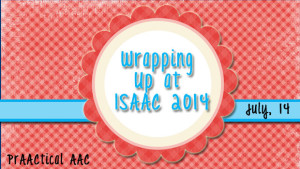
Today we wrap up the ISAAC 2014 Biennial Conference, where people who use AAC and people who support them through research, teaching, and direct services came together for one purpose: sharing. Yesterday, I had the privilege of presenting a 2-hour session with Dr. Gloria Soto from San Francisco State University. You can download our handout here or in the AAC e-Toolbox.
Filed under: PrAACtical Thinking
Tagged With: Gloria Soto, handout, ISAAC 2014, vocabulary
July 23, 2014
by Carole Zangari -
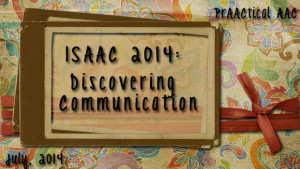
ISAAC 2014 is going strong! I had the pleasure of presenting a case study with Levi and Linda Parras. Levi told his story of recovering from a brain herniation at age 16. You can see your handout here or in the AAC eToolbox.
Filed under: PrAACtical Thinking
Tagged With: handout, ISAAC 2014, Levi Parras, Linda Parras, presentation, recovery
July 22, 2014
by Carole Zangari -
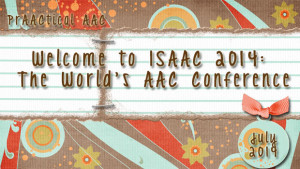
Welcome to ISAAC 2014! I know many of you wish you could be here in Lisbon learning along with me from the world’s top AAC researchers, practitioners, families, and consumers. What an exciting place to be! For those of you unable to make the trip, I encourage you to start planning and saving your pennies for the next ISAAC conference in 2016. In the meantime, I’ll try to do some sharing here to give you a peek at all of the AAC goodness happening here in Lisbon this week. My highlight so far was presenting with Jane Farrall. Both of us have a passion for teaching literacy to people with AAC needs, but in this presentation, our focus was on using literacy experiences to teach communication skills. You can check out our handout below or in the AAC eToolbox.
Filed under: PrAACtical Thinking
July 21, 2014
by Carole Zangari -
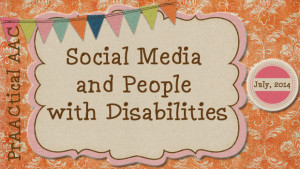
If you’re an AAC lover there’s no better place to be this week than the 16th the Biennial Conference of the International Society for AAC (ISAAC) at the Lisboa Congress Centre. Every two years, AAC stakeholders from around the world gather to consider the latest research, learn from one another, discuss issues of controversy, see new products. connect and renew relationships, and have a great time. From the pre-conference workshops, to the AAC Camp, to the main conference, to the Exhibit Hall, to the Research Symposium, this is the place to be to get AAC inspiration. There won’t be much time for writing but we’ll try to keep you posted with photos from the conference. You can also follow along on Twitter with the conference hashtag, #ISAAC2014 To start get in the ISAAC mood, check out this presentation by Lisa Lehman, the 2012 Outstanding Consumer Lecturer.
Filed under: PrAACtical Thinking
Tagged With: Conference, ISAAC, Lisa Lehman, social media
July 19, 2014
by Carole Zangari -
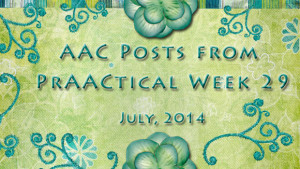
As many of you know, it was a very sad week for PrAACtical AAC and many of our friends. Thanks to all who reached out with comments, emails, Facebook messages, and texts. Sunday: Video of the Week – The Right to Be Heard Monday: A PrAACtical Resource – Communication Access Tuesday: AAC Knowledge and Skills for SLPs Wednesday: Watch It Wednesday – Selfie Bandit Thursday: PrAACtically Heartbroken Friday: On Autism and AAC
Filed under: PrAACtical Thinking
July 18, 2014
by Carole Zangari -
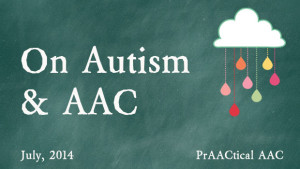
Today we are revisiting some of Robin’s most popular posts. 30 Ways to Celebrate Autism Awareness Month AAC Must-Have’s for the Classroom and Therapy Room The First 12: Getting Started with Core Words Literacy For Everyone with Adapted Books Beyond Requesting: Using Scripts to Teach Conversation AAC Goals That Matter Creating Communication Boards: There are Lot of Apps for That! Join Together: Core and Fringe Vocabulary Beyond Requesting: Let’s Chat with Peers Begin AAC Now: 10 Things to Do
Filed under: PrAACtical Thinking
Tagged With: ASD, friendship, robin parker
July 17, 2014
by Carole Zangari -
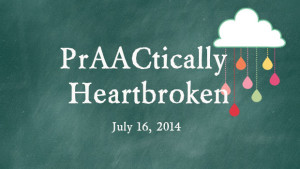
“I have lost more than a beloved friend. I have lost an inspiration. She would rather light a candle than curse the darkness, and her glow warmed the world.” (Adlai Stevenson)
Filed under: PrAACtical Thinking
Tagged With: ASD, friendship, robin parker
July 16, 2014
by Carole Zangari -

The only thing that makes us happier than seeing AAC take center stage is when it doesn’t. We loved watching this camp video in which one of the actors just happens to use AAC. Direct Link to Video: https://www.youtube.com/watch?v=82XyZ9SwKu8&list=UUV9eMzg1kYuYd_hcfJZGWyQ
Filed under: PrAACtical Thinking
July 15, 2014
by Carole Zangari -
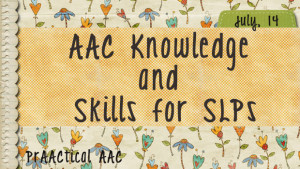
What should SLPs know and be able to do in order to provide AAC services? Here’s what ASHA has to say about that. ::::::::::::::::::::::::::::::::::::::::: American Speech-Language-Hearing Association. (2002). Augmentative and alternative communication: knowledge and skills for service delivery [Knowledge and Skills]. Available from www.asha.org/policy.
Filed under: PrAACtical Thinking
Tagged With: ASHA, Knowledge and Skills
July 12, 2014
by Carole Zangari -
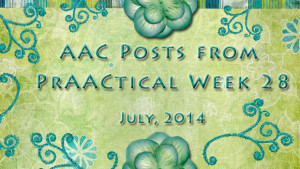
Sunday: Video of the Week – Writing Instruction for Students with Angelman Syndrome Monday: Strategy of the Month: A PrAACtical Resource – AT for the Little Ones Tuesday: Research Tuesday – Supporting Children with Severe and Profound Multiple Disabilities Wednesday: 5 Ways to Store Picture Symbols Thursday: Things to Try with AAC Learners Who Have Short Attention Spans Friday: What We Know: AAC & Pre-Requisites
Filed under: PrAACtical Thinking









